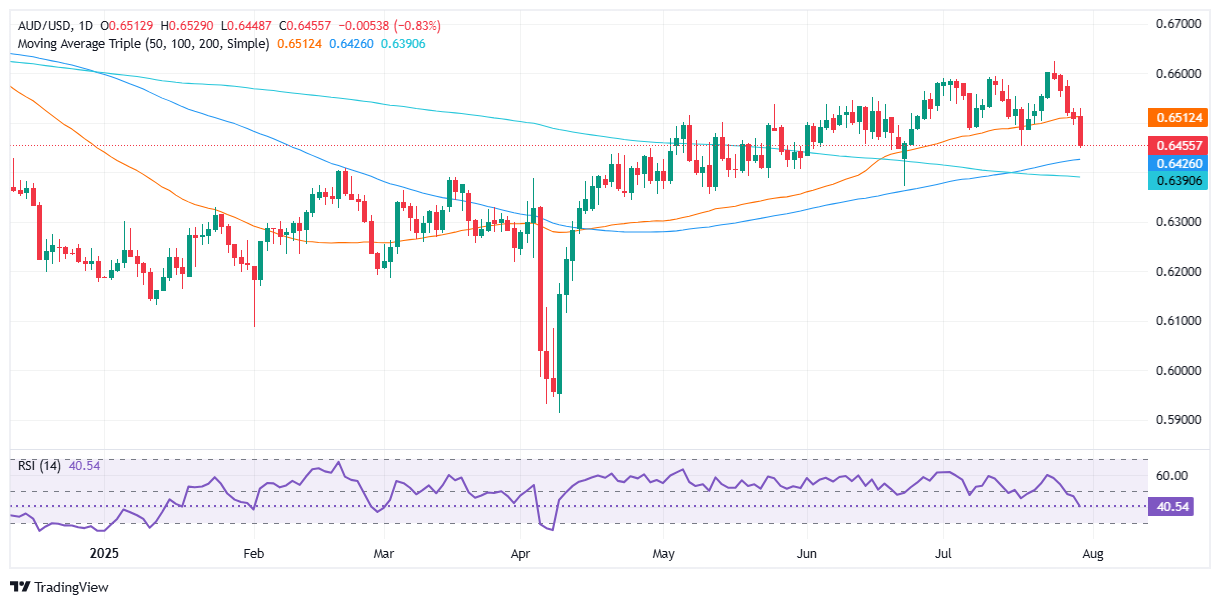- The Fed keeps the stable rates; Two governors voted in favor of a 25 basic point cut.
- The statement indicates “high uncertainty” and moderate growth in the first semester.
- The EUR/USD volatilely quotes about 1,1475, with attention to the key support in 1,1450.
The Aud/USD collapses on Wednesday, extending its agony for the fourth consecutive day after the decision of the Federal Reserve (Fed) to keep the fees, although not unanimously, since two officials, Waller and Bowman, who had anticipated their intentions before the period of silence, disigned and voted in favor of a 25 basic points. At the time of writing, the par quotes volatile within 0.6448, with a fall of 0.76%.
In its last policy statement, the Federal Reserve said that economic activity has been moderated during the first half of the year, while the unemployment rate remains low and inflation is described as “something high.” The officials reiterated their commitment to achieve maximum employment and bring inflation back to the objective of 2%, while emphasizing that “uncertainty about economic perspectives remains high.”
The Fed also confirmed that it will continue to reduce its treasure securities, debt of agencies and values supported by mortgages. The markets now focus their attention on the press conference of the president of the FED, Jerome Powell, which is being carried out at this time.
AUD/USD reaction to the Fed decision
The AUD/USD is listed volatile within the range of 0.6454-0.6471 established by the reaction to the Fed decision, limited to the rise for the figure of 0.6500 before the 50-day SMA in 0.6536. If President Powell adopts a dovish tone during the Question and Answers session, a higher pricing test is expected.
On the contrary, a hard line reaction paves the way to test the minimum of 0.6424, where the 100 -day SMA is located, followed by the 0.6400 mark and the 200 -day SMA at 0.6394.

Fed – Frequently Questions
The monetary policy of the United States is directed by the Federal Reserve (FED). The Fed has two mandates: to achieve prices stability and promote full employment. Its main tool to achieve these objectives is to adjust interest rates. When prices rise too quickly and inflation exceeds the objective of 2% set by the Federal Reserve, it rises interest rates, increasing the costs of loans throughout the economy. This translates into a strengthening of the US dollar (USD), since it makes the United States a more attractive place for international investors to place their money. When inflation falls below 2% or the unemployment rate is too high, the Federal Reserve can lower interest rates to foster indebtedness, which weighs on the green ticket.
The Federal Reserve (FED) celebrates eight meetings per year, in which the Federal Open Market Committee (FOMC) evaluates the economic situation and makes monetary policy decisions. The FOMC is made up of twelve officials of the Federal Reserve: the seven members of the Council of Governors, the president of the Bank of the Federal Reserve of New York and four of the eleven presidents of the regional banks of the Reserve, who exercise their positions for a year in a rotary form.
In extreme situations, the Federal Reserve can resort to a policy called Quantitative Easing (QE). The QE is the process by which the Fed substantially increases the flow of credit in a stuck financial system. It is a non -standard policy measure used during crises or when inflation is extremely low. It was the weapon chosen by the Fed during the great financial crisis of 2008. It is that the Fed prints more dollars and uses them to buy high quality bonds of financial institutions. The one usually weakens the US dollar.
The quantitative hardening (QT) is the inverse process to the QE, for which the Federal Reserve stops buying bonds from financial institutions and does not reinvote the capital of the bonds that it has in portfolio that they expire, to buy new bonds. It is usually positive for the value of the US dollar.
Source: Fx Street
I am Joshua Winder, a senior-level journalist and editor at World Stock Market. I specialize in covering news related to the stock market and economic trends. With more than 8 years of experience in this field, I have become an expert in financial reporting.







